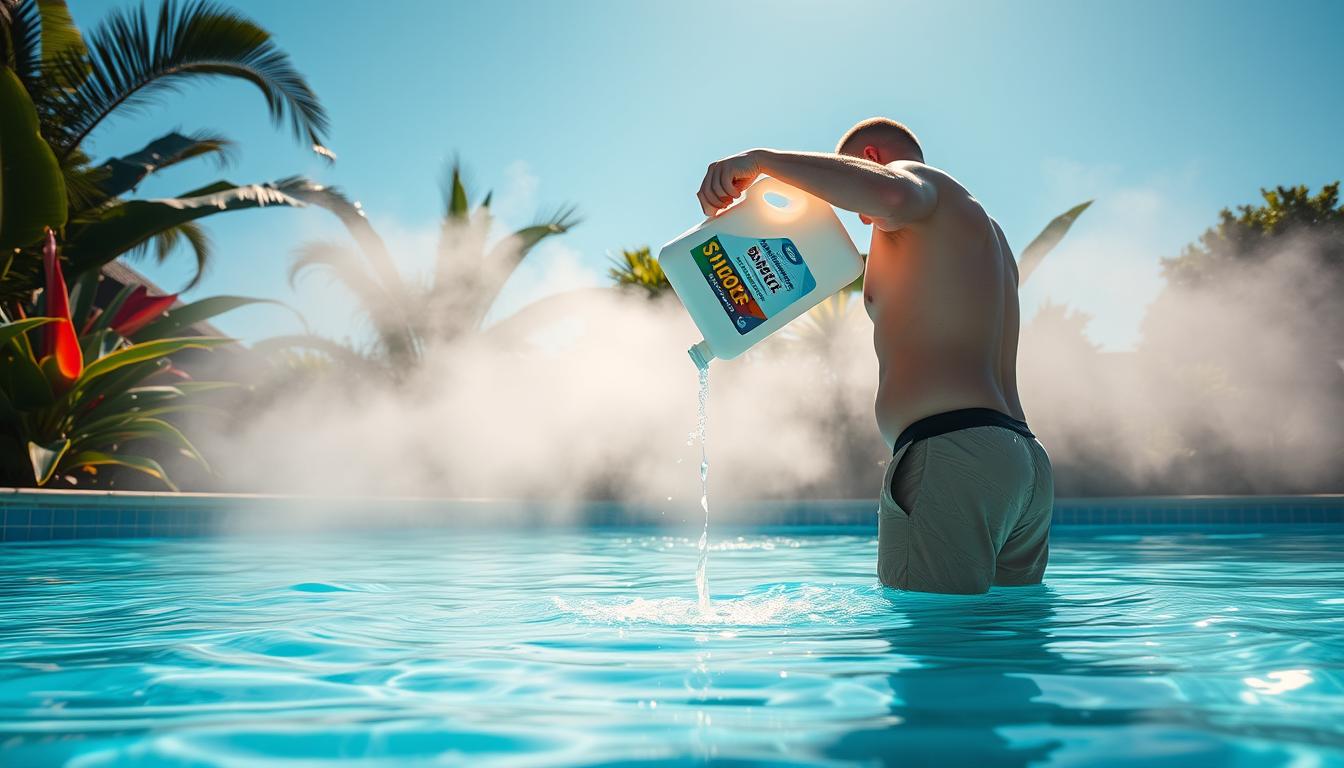
Saltwater pool owners often wonder about shocking their pools. These pools are known for being low-maintenance. Many pool enthusiasts say they’ve never used shock treatments, thanks to their saltwater chlorine generator (SWCG).
The need for shocking saltwater pools is hotly debated. Some pool owners swear by regular saltwater pool chlorine shocking. Others say proper maintenance makes saltwater pool shock treatment unnecessary.
So, do you have to shock a saltwater pool? Let’s explore saltwater pools and discover the truth about when to shock saltwater pool.
Understanding Pool Shocking and Its Importance
Pool shocking keeps saltwater pools clean and safe. It’s a key part of pool care. Learning about pool shocking helps owners create a good schedule.
What is Pool Shocking?
Pool shocking adds a high dose of chlorine to pool water. This kills bacteria, algae, and removes chloramines. It raises chlorine levels for a short time to clean the water.
The process makes pool water clear and safe again. Pool shocking uses 1-2 pounds of shock per 10,000 gallons of water.
Pool shocking involves adding between 1-2 pounds of shock for every 10,000 gallons of water in the pool.
Why Pool Shocking is Essential
Regular pool shocking keeps swimming areas healthy. It kills harmful germs and stops algae growth. Pool shocking also removes chloramines that irritate eyes and skin.
- Eliminates contaminants and prevents the growth of harmful bacteria and algae
- Removes chloramines, which cause eye and skin irritation and produce unpleasant odors
- Maintains clear and visually appealing water
- Ensures safe swimming conditions for all users
Pool shocking is crucial when opening or closing a pool. It’s also important after parties or heavy rain. Shock your pool if swimmers have skin or eye irritation.
Types of Pool Shock Treatments
There are several types of pool shock treatments. Each has its own benefits. Here are some common types:
| Type of Shock | Description |
|---|---|
| Calcium Hypochlorite | A popular choice known for its strong oxidizing properties and ability to rapidly increase chlorine levels. |
| Dichloroisocyanuric Acid (Dichlor) | A stabilized form of chlorine that is suitable for outdoor pools due to its longevity under sunlight exposure. |
| Potassium Monopersulfate | A non-chlorine alternative ideal for swimmers sensitive to chlorine and for preventing chloramines in spas and hot tubs. |
| Liquid Chlorine | Effective for large pools as it disperses quickly, providing a rapid increase in chlorine levels. |
Choose a shock based on your pool type and sun exposure. Consider how easy it is to use and how well it works. Always buy shock from trusted brands for the best results.
Maintaining Saltwater Pools: The Role of Shocking
Clean saltwater pools are essential for enjoyable swimming and long-lasting equipment. Shocking helps maintain pools, but its frequency differs between saltwater and traditional pools. Understanding these differences is crucial for proper pool care.

Differences Between Saltwater and Traditional Pools
Saltwater pools use chlorine generators to convert salt into chlorine. Traditional pools require direct chlorine addition. This results in lower, more stable chlorine levels in saltwater pools.
Here are some key differences between the two pool types:
| Saltwater Pools | Traditional Pools |
|---|---|
| Use a chlorine generator to convert salt into chlorine | Require direct addition of chlorine |
| Have lower and more stable chlorine levels | Experience more fluctuations in chlorine levels |
| Produce less chloramines compared to store-bought chlorine pools | Can increase total dissolved solids, making water feel harder on the skin |
| Gentler on nearby plants but can cause corrosion on metal objects | Require regular purchases of balancing chemicals |
Shocking Frequency for Saltwater Pools
Saltwater pools may only need shocking in specific situations. These include opening or closing the pool, after heavy rain, or when addressing water quality issues.
- Opening or closing the pool for the season
- After heavy rain or storms
- When addressing specific water quality issues
Regular testing and adjusting chlorine generator output often eliminates frequent shocking needs. If chlorine levels drop too low, use a compatible chlorine-based shock or add liquid chlorine.
Monthly water tests are recommended for maintaining proper water balance to uphold warranties on pool equipment and pool liner validity.
Follow a regular maintenance schedule for optimal saltwater pool performance. This includes cleaning the salt cell and changing filter media as needed.
- Chemically cleaning the salt cell once a season with Salt Cell Saver
- Changing filter media for sand filters every 3-5 years or sooner if not chemically cleaned each season
- Applying silicone lubricant to o-rings at the beginning and end of every pool season to prevent improper seals
- Regularly brushing down walls and floor, cleaning skimmer and pump baskets, and limiting automatic vacuum use to 6 hours at a time
Proper maintenance routines minimize shocking needs. This helps maintain clear, safe, and inviting swimming water in saltwater pools. Understanding pool differences and following these tips ensures a great swimming experience.
Do You Have to Shock a Saltwater Pool?
Shocking isn’t always needed for well-maintained saltwater pools. Regular testing and adjusting the chlorine generator output often suffice. Saltwater pools typically have lower chlorine levels, making them gentler on skin and eyes.
Shock treatment can be useful when opening or closing the pool. It’s also helpful after heavy use or contamination. Algae growth and high chloramine levels may require shocking too.
Saltwater pools can be more cost-effective long-term. They need fewer additional chemicals and have lower maintenance costs. This creates a more sustainable pool environment.
The decision to shock should be based on pool conditions and water tests. It’s not a fixed schedule. Salt levels should be between 2,700 to 3,400 parts per million (PPM).
Weekly testing of pH, Free Chlorine, Total Chlorine, Alkalinity, and Calcium Hardness is crucial. Consult a professional or learn about saltwater pool chemistry to determine when shocking is necessary.







